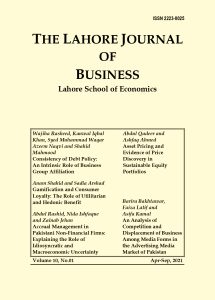The Determinants of International Certification among Manufacturing Firms in Pakistan
- Farrukh Iqbal
- Fiqbal@iba.edu.pk
- Dean and Director (Retired) Institute of Business Administration, Karachi
- Aadil Nakhoda
- anakhoda@iba.edu.pk
- Assistant Professor Institute of Business Administration, Karachi
- (Corresponding Author)
Submitted
November 22, 2023
Accepted
November 22, 2023
Accepted
November 22, 2023
- Received
- 3 December 2023
- Revised
- 31 January 2024
- Accepted
- 9 May 2024
Abstract
This study investigates the factors that influence international certification among Pakistani manufacturing firms. About a third of such firms in Pakistan hold one or more certificates related to management or technical processes. The existing literature suggests that this demand is influenced by factors such as sector of activity, market competition, human capital and information environment, ownership type, and available resources. By analyzing a large, random sample of Pakistani manufacturing firms, we find strong correlations between these factors and international certification. We also discover that owner attitude, an aspect overlooked in previous studies, plays a role in the certification decision. While our statistical model does not fully explain the determinants of certification for small firms, we do find that certification is associated with increased profitability among small enterprises. This implies that small enterprise development agencies can improve the effectiveness of their programs by considering certification status as an additional criterion for allocating support funds. The results of our study have policy implications related to exporting, staff training, diffusion of firm ownership, and enhanced information access facilitated by modern technology tools
Keywords
International certification
SME policy
product market competition
training
information environment
ownership diffusion.
This work is licensed under LJB.
- Citation
Iqbal, F., & Nakhoda, A. (2024). The Determinants of International Certification
among Manufacturing Firms in Pakistan. The Lahore Journal of Business, 11(2), 1-28.
- References
- Adler, M. D., & Posner, E. A. (2000). Introduction to cost-benefit analysis. Journal of Legal Studies, 29, 837.
- Biazzo, S., & Bernardi, G. (2003). Process management practices and quality systems standards: Risks and opportunities of the new ISO 9001 certification. Business Process Management Journal, 9(2), 149–169.
- Bloom, N., & Van Reenen, J. (2010). Why do management practices differ across firms and countries? Journal of Economic Perspectives, 24(1), 203–224.
- Cao, X., & Prakash, A. (2011). Growing exports by signaling product quality: Trade competition and the cross‐national diffusion of ISO 9000 quality standards. Journal of Policy Analysis and Management, 30(1), 111–135.
- Choudhary, A., Lemos, R., & Van Reenen, J. (2018). Management in Pakistan: Performance and conflict (Working Paper F-89459-PAK-1). International Growth Centre.
- Dick, G. P., Heras, I., & Casadesús, M. (2008). Shedding light on causation between ISO 9001 and improved business performance. International Journal of Operations and Production Management, 28(7), 687–708.
- DiMaggio, P. J., & Powell, W. W. (1983). The iron cage revisited: Institutional isomorphism and collective rationality in organizational fields. American Sociological Review, 48(2), 147–160.
- Dos Santos, M. G., Borini, F. M., Pereira, R. M., & Raziq, M. M. (2020). Institutional pressures and the diffusion of organizational innovation: Evidence from Brazilian firms. Technology Analysis and Strategic Management, 32(7), 869–880.
- Fatima, M. (2014). Impact of ISO 9000 on business performance in Pakistan: Implications for quality in developing countries. Quality Management Journal, 21(1), 16–24.
- Fikru, M. G. (2014). Firm-level determinants of international certification: evidence from Ethiopia. World Development, 64, 286–297.
- Gallego, J. M., & Ramírez, L. H. G. (2021). Quality certification and firm performance. The mediation of human capital. International Journal of Productivity and Performance Management, 72(3), 710–729.
- Goedhuys, M., & Mohnen, P. (2017). Management standard certification and firm productivity: micro-evidence from Africa. Journal of African Development, 19(1), 61–83.
- Goel, R. K., & Nelson, M. A. (2020). Do external quality certifications improve firms’ conduct? International evidence from manufacturing and service industries. Quarterly Review of Economics and Finance, 76, 97–104.
- Goldar, B., & Majumder, P. (2022). What factors drive industrial plants in emerging economies to adopt ISO 14000 environmental management standards: Evidence from the Indian organized manufacturing sector. Environmental Development, 44, 100771.
- Greenwood, R., & Meyer, R. E. (2008). Influencing ideas: A celebration of DiMaggio and Powell (1983). Journal of Management Inquiry, 17(4), 258–264.
- Hayat, N., Hussain, A., & Lohano, H. D. (2018). What drives a textile firm to adopt an eco-label? Business Review, 13(1), 1–20.
- Hayat, N., Hussain, A., & Lohano, H. D. (2020). Eco-labeling and sustainability: A case of textile industry in Pakistan. Journal of Cleaner Production, 252, 119807.
- Hudson, J., & Orviska, M. (2013). Firms’ adoption of international standards: One size fits all? Journal of Policy Modeling, 35(2), 289–306.
- International Organization for Standardization. (2022). The ISO Survey 2022. https://www.iso.org/the-iso-survey.html
- Iqbal, F., & Nakhoda, A. (2024). Determinants of management practices among manufacturing firms in Pakistan. Pakistan Development Review, 63(1), 45–64.
